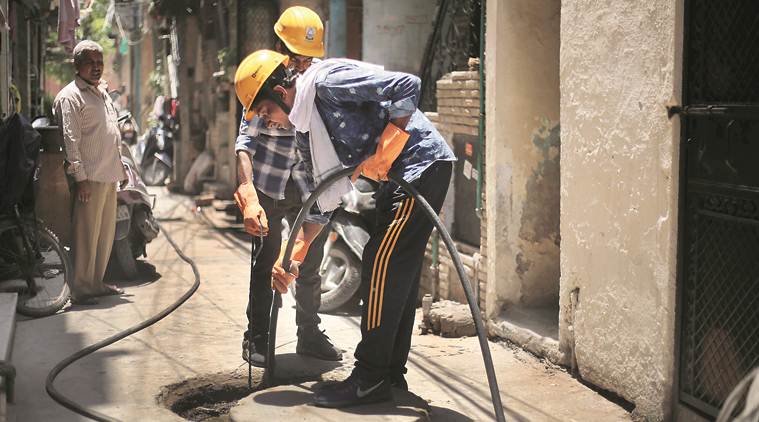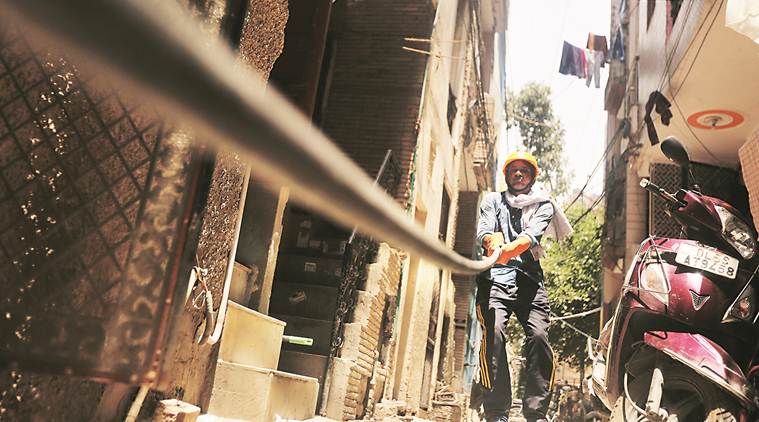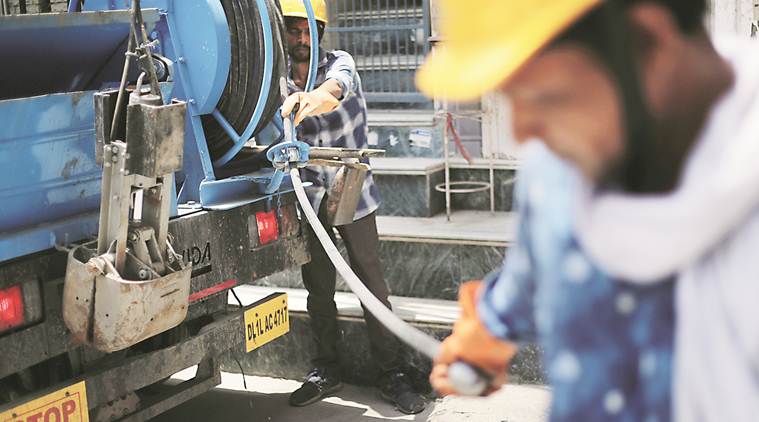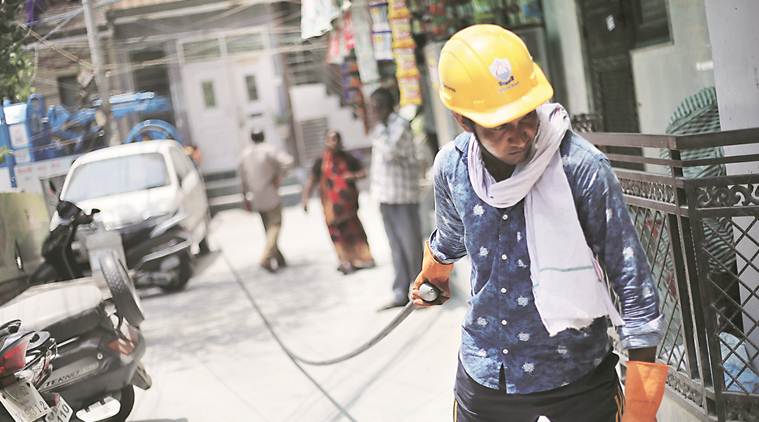
The image stuck in Jaspal Singh’s head is of his father hunched over three other men inside a septic tank in Ghitorni on July 15, 2017. That is the last time he saw him alive, before jumping in behind him. “Everything went black after that. I woke up an hour later, being rushed to the hospital. I was told my father and cousin, along with two men from the neighbourhood who entered the tank before me, were dead,” said Jaspal, the lone survivor.
Two years on, the 24-year-old regularly runs from Patiala House Courts Complex to the Delhi High Court trying to ensure justice for the dead.
April, though, brought some good news — Jaspal and his mother Gurmeet Kaur became the first owners of specially designed sewer cleaning machines, which the Delhi Jal Board (DJB) and Dalit Indian Chamber of Commerce and Industry (DICCI) helped them get.
The plan is for the Delhi government to help relatives of manual scavengers who died cleaning sewers or septic tanks, by getting them bank loans at low interest rates, registering machines in their names, and starting small companies so they can become contractors. The Jal Board has assured them contracts for seven years to make sure they can earn roughly Rs 40,000 per month and repay the loan.

It was a spate of sewer deaths in the national capital over the last two years that sent government officials and social workers into a huddle. They eventually came across a similar model being followed by DICCI in Hyderabad.
The Delhi government and DICCI started work on the project proposal last year, and in August — a year after the Ghitorni incident — the DJB announced it was working on a project to help manual scavengers become financially independent.
Two hundred such machines were supposed to be rolled out, with sanitation workers, manual scavengers and their families getting priority.
Convincing them the project could work was the second challenge. “People discouraged them, said we were trying to fool them, but we persisted. Some started receiving threats — no one wants to see these people rise. Many pulled out of the project because they had been paid off by contractors or building owners after their relatives died and they did not want conflict with them anymore,” said Mukesh Virat (34), a Dalit activist who, for the past two years, has been working with families of men who have lost their lives in dark sewers.
Jaspal’s mother Gurmeet and aunt Maya, whose son also died in the Ghitorni incident, said they too were sceptical. “Men died doing this before my son Inderjeet, and men died after. This case was widely reported so we knew we would get some compensation from the government. Then, a month later, Mukesh came to us and said we would get a machine that would provide a steady income. We thought this might just be another promise but because these were the people who had helped us out since the beginning, we took interest,” said Maya.
“But it was only in February, when the chief minister (Arvind Kejriwal) called us all for an event at a big stadium, that we believed it. Before that, the machines were shown to us at the DJB’s Keshopur office. When the CM said it in public, I knew something would happen for sure,” she added.

Two machines belonging to Gurmeet and Maya have been on the ground for two months, but the first payment is yet to come. “Unhone bola hai 2-3 mahine lagenge. Hum wait karenge (They told us it will take 2-3 months, we will wait),” said Gurmeet.
All in a day’s work
Over 30 km away in Mukherjee Nagar’s Nehru Vihar, three men gear up for a long day under the sun. Vijay Singh (30) drives into a narrow lane from where the DJB received a sewer blockage complaint. Dilip (33) and Parvesh (27) deboard the six-foot-wide blue, green and white mini-truck, which has a tank, pipes and an external power source on the bed.
The three men drive and operate Gurmeet and Jaspal’s sewer cleaning machine, but have never met either of them. When Vijay hears the story of how the mother-son duo got the machine, he said, “Kaam toh bohot dangerous tha. Hum bhi akhbaar mein padhte the. Par humein training mili thi aur ye samjhyaya tha ki kabhi bhi naali mein nahi utarna (The work was very dangerous. We would read it in the papers. When we were trained for the machine, we were warned never to enter a drain).”
Vijay used to drive a garbage tipper for municipal corporations on a contractual basis. “We weren’t paid regularly so I quit. I would earn around Rs 12,000 a month; here I make a minimum wage of Rs 16,982. So far, the payment is on time,” he said.
Dilip and Parvesh, meanwhile, put on their hard hats, gloves and masks.
Dilip used to be a cleaner at a private bank until 2017, when he lost his job after demonetisation. He was unemployed when a contractor told him about this job. “I was cleaning then and I am cleaning now. I would barely earn Rs 8,000, so this is much better. I know never to enter a sewer line,” he said, pulling a long, thick wire off the bed of the truck. He earns Rs 14,922 as a helper on the sewer cleaning machine.

Parvesh worked as a movie ticket salesman at a Faridabad mall before he took this job. “The company shut down and I was jobless. This work is okay. Sometimes the smell is overwhelming but I can support my family this way,” he said, attaching a grabbing tool to the end of the metal wire.
Among the first jobs the trio undertook was in a narrow lane in Okhla Industrial Area Phase II in April. As customers ate at a roadside dhaba, a foul stench emanated from a blocked sewage pipe running under it.
Sunil Rana, the dhaba owner, said he had filed several complaints about the blockage, and was used to a team of three-four people landing up. “They would open the lid and a man would be sent in. That was the usual practice and that’s what we are used to. We’ve heard about people dying in sewers and it was always at the back of my mind, but what was the option?” he said.
What arrived instead was the new machine and the team of three men.

Of the 200 machines that are to be deployed across the city, 100 have already got permits and are now running. The machine does three things — grabbing, roading and jetting. There are different tools for each purpose and they are powered by the battery on the truck bed. A 1,000 litre tank provides a water source where there is none.
The easiest, Dilip said, is grabbing. A jaw-like tool attached to the metal wire, the grabber goes into the tank or sewer line and grabs any dry garbage that might be blocking the line. They mostly find plastic waste and leaves.
At the dhaba, power from the truck stops midway through the process. After a scramble, the dhaba owner allows the men to draw a line from the premises. The work resumes. “It happens. It’s a machine, such problems are expected. People usually offer help. After all, they want the work to end as soon as possible,” Vijay said.
The team moves on to the second stage — roading. They pull out the wire, remove the grabbing tool, and replace it with a hook-shaped one. It is used if there is wet waste or solid objects that is difficult to get to during grabbing, such as clothes, rocks and coagulated masses. Another tool used for roading is a diamond-shaped attachment that can cut through stone and pull out rags. At the dhaba, this works. A long piece of cloth is finally pulled out and the blockage is removed. To make sure all is well, the team finally uses the jetting tool. It sends a pressurised stream of water inside the line to make sure there are no obstructions.
“It is usually the first thing we use, but if we pump in water and see that it is bubbling back up, we proceed to other options,” said Parvesh.
Vijay said that in the last two months, they haven’t encountered any major problems. “Small things crop up here and there. If the sewer is too deep for us, we tell the DJB and they send in their super sucker machines,” he said. The super sucker machines, which have been with the DJB for several years now, are the size of a 10-12 wheel truck and cannot enter narrow lanes.
Capital’s shame
To many, the machines offer a ray of hope at the end of a very dark and deadly tunnel. Despite a ban on manual scavenging, the capital has failed when it comes to keeping the most disenfranchised out of its sewers. Since February, when Kejriwal announced that machines will be introduced, five men in Delhi-NCR have died while cleaning sewer lines or septic tanks. While the machines should, in the long run, be used to clean sewer lines and septic tanks in areas under the government, private property remains unregulated and largely unchecked.
When they undertook the contract to clean the tank in Ghitorni, Jaspal and the others were told it was a rainwater harvesting tank. “My father spoke to the farmhouse owner in Ghitorni. He was told there was no danger and that’s why he wasn’t even on the spot that day. When the first man went in, he fainted within minutes. The second went in to save him, and then the third. I called my father in panic. He came rushing, tied a rope around his waist and went into the pit. He too fainted almost immediately. Finally, it was my turn. I think by then some bystander had figured out we were in trouble and called the police as soon as I fainted,” he recalled.
A process to fix accountability for non-government projects is sorely lacking. Till date, Jaspal spends hours in court to make sure the accused’s bail gets cancelled. “He stayed in jail for around seven months but was granted bail in March. We filed a petition in the Delhi High Court to oppose that, and the case is on,” he said.
“Many such cases are never reported. The poor are threatened and asked to cut deals with property owners, who pay a few lakhs and hush up the matter. They are intimidated by courts and police and decide it’s better to be silent than to pursue justice,” said Mukesh.
For Gurmeet, every death inside a sewer is a painful reminder of her personal tragedy: “Just two weeks ago, Maya and I saw three men hunched over a sewer at a market. I wondered then, will this ever end?”